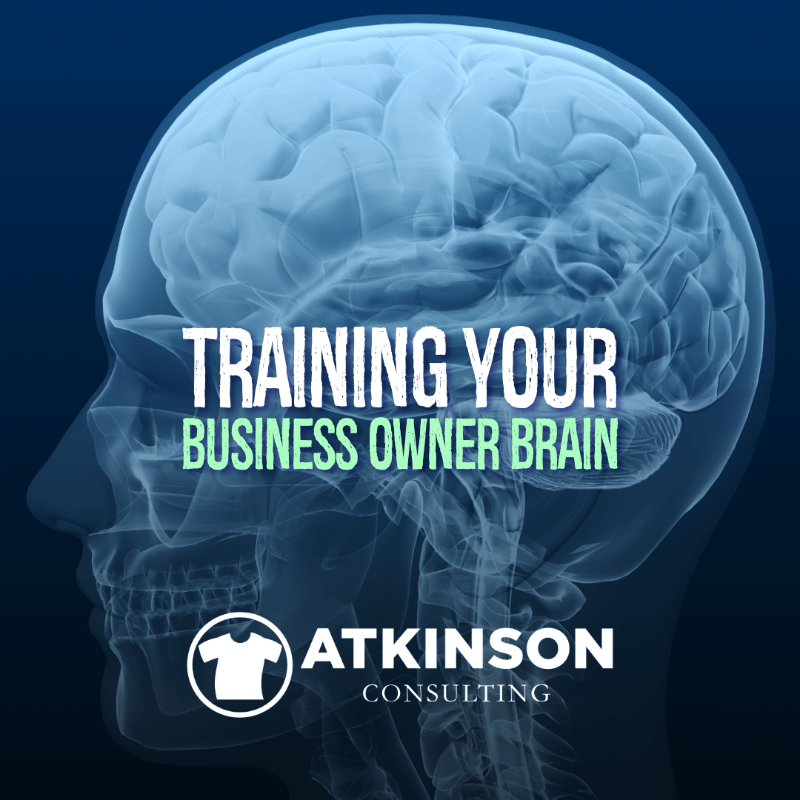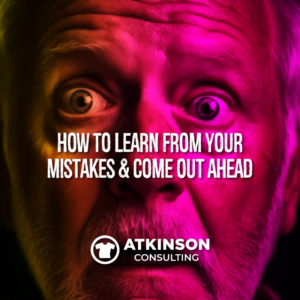Owning and running a business is hard. If it were easy, everyone would do it.
You know this, as daily you pour your soul into running your company. But, in the chaos of day to day decision making a few things can get easily overlooked or simply pushed aside.
This article is about “Training Your Business Owner Brain” to see things from a different perspective. There are some key concepts that you should keep in mind that will help you in the long run.
Time
There are only so many hours in the day. How you choose to spend them has a direct correlation to the success of your business.
For starters, I want you to consider what an hour of your time is worth. $50? $100? $150? $200? More? Really consider this and name a number.
Why is this important?
Because practically every day you spend your time working on things that you aren’t skilled at doing, don’t like doing, or are low priority tasks that you shouldn’t be doing.
Raise your hand if this is true.
Try this: Take a legal pad out and during your week jot down those types of tasks that you find yourself handling in your business. What are they? How much time are you spending on them?
So instead of working on higher priority and more important work, you find yourself deep in the trenches wallowing in tasks that you can find someone else to do for far less.
I know what you are thinking. “Marshall, I’m saving money by doing those things. I don’t have to hire someone and this keeps my labor rate down.”
I totally understand why you think that way. However, when you are doing any of those lower priority tasks, you are not working on growing your business.
You aren’t saving any money, you are simply hamstringing your growth potential.
I can’t tell you how many shops I’ve been to where they were incredibly busy for months on end, and then the work simply dried up. It’s like the sales drove off a cliff.
What happened?
The owner was too caught up in the day to day and didn’t focus on what’s coming down the pike six to eight weeks from now. This is typically how the feast or famine sales cycle works in this business.
Your Challenge: Time
To retrain your brain, start keeping track of the ratio between high priority and low priority work that you spend your time working on a daily basis. You definitely need to keep your finger on the pulse of the shop as to what’s current, but in order to grow your business, the majority of your time should be spent thinking ahead.
What’s in the sales funnel? What marketing ideas are we developing for next quarter? Are there opportunities out there that we can bring in? What is the biggest problem I can tackle today? What low-profitable jobs are on our schedule right now that we should be saying NO to?
Prioritize your day so you are working ON your business and not IN your business.
Sales
Why do businesses wither up and die?
Usually, it is due to a lack of sales. Orders coming into your shop are the lifeblood of your business.
Yet knowing that plenty of shop owners simply rely on the phone to ring, foot traffic, or their website to drive home sales. As my friend Mark Coudray puts it, “they are oysters at the bottom of the ocean waiting for that order to land in their mouth”.
That isn’t a sales strategy that will give you mind-blowing results.
But here’s the ironic thing. When I talk to shop owners one of the first questions I ask is, “Do you have a business plan?” Easily 60-75% of them respond with a “No”.
Why is this important?
Because a business plan gives you a tool to focus directly on the customers that are in alignment with what you offer, and value the work that you bring to the table. It’s how you hit the sales bullseye. This is how you create your “Unique Selling Proposition”. A business plan allows you to choose who you want to do business with on a daily basis.
As the owner of the business, it is your responsibility to pick a lane. You need to define who is your best customer, and why. If you do this correctly and build a robust marketing plan that works in conjunction with your business plan, potential customers will start coming after you to do their work.
Planning is anticipatory decision making.
When you do the work and research and develop a business plan that truly defines your best customers, you have given your business a fantastic tool to use. That plan helps guide your effort with your time. When you know who are the best customers for your shop, it’s easy to develop strategies to go after them.
Juxtapose that with the idea of “anyone that walks in the door”. How are you going to develop anything sticky with that narrative? Instead, focus like a laser on finding the unique niche that works best for you.
It should be an inch wide, but a mile deep. A Unique Selling Proposition is a commodity-pricing kryptonite. Specialize.
Your Challenge: Business Planning
Spend some time doing the research and define exactly who are the best customers for your business. Don’t take just any work. Build your business to go after more profitable customers that truly value what you bring to the table. Write a business plan that details your best customer and best order. Review this at least twice a year.
Don’t have a business plan? Use the template in my best-selling eBook, “Shop Basic Info Pack”.
Culture
Business culture can be likened to the company’s personality.
In your shop, do you have a culture of “getting things done”, or one of “Mother, may I?” where everyone stops and asks you permission to do the next thing?
Great company culture is 100% about who you let on your team.
Are you fielding a team of superstars that work in concert together with teamwork? Or, are you staffing with a bunch of finger-pointing excuse-makers?
Maybe a mix of both?
For Culture, when you talk all the time about execution and performance it is more than likely to happen. If you never discuss it or don’t champion it, you’ll find your results will be lacking.
In Tom Peters’s book “The Excellence Dividend”, he cites the McKinsey 7 S model to define culture.
- Strategy
- Structure
- Systems
- Style
- Skills
- Staff
- Shared Value
In your shop, how would you rate those seven “S”s on a scale of 0 to 10? As a business owner, it is your job to ensure that your culture is the best that you can build.
This is what is going to give you a competitive edge.
Your Challenge: Build a Better Culture
Will Rogers once said, “Never miss a good chance to shut up”. Spend time with your employees. What are their problems? How do they see the future? What are their ideas? Remember, if you ask a question and don’t ask two or three follow up questions, then you weren’t really listening.
Your customers will never be any happier than your employees. Your aim is for your company to be the “best place to work”. Remember, “a fish rots from the head.”
The culture of your company is a reflection of you.
Are You Focusing on HOW or WHO?
Earlier in this article, I wrote about how managing your time is crucial to your success. For this point, I want to add something to it.
The difference between working on HOW or WHO.
“How” is simply a statement on “how are we going to solve that problem” or “how are we going to do something”. These are the steps that you should take to accomplish something.
For example, the production schedule isn’t functioning correctly and you are backed up by at least four business days. “How are we going to get caught up?”
“Who” is something completely different. “Who” points to the champion that you can align yourself with to solve that “How”.
In our example, the production schedule doesn’t work. “Who can you bring in to build a better process so the schedule is on time and correct on a consistent and predictable basis?”
Why be backed up in the first place?
As a business owner, your job is to think outside of the company and realize that there are people, products, equipment, and education available to you that can help you master your business.
“Who” is that connection that can streamline those processes. The right “Who” solves the “How”.
Your Challenge: Networking
It’s easy to sit in your office bubble and think you know everything. The fact is that this industry has too many variables and problems. If anybody tells you they know everything, they are full of it.
We are all on our journey of learning. The fact of the matter is that someone out there has the exact answer for what is plaguing your business. Your job is to discover the “Who” that can help you best.
This is where networking opportunities at trade shows, industry events, social media groups, and meet-ups can save the day. Get out and meet people. Introduce yourself. Ask questions.
Remember, your best friend is only a handshake away.
Feeding Your Owner’s Brain
What is the sign of intelligence? Being able to change your mind.
Understanding that you don’t know everything, and because of that craving new information is a hunger.
I personally like to read books. I’ve written about that before, but I also know that it isn’t everyone’s style. Podcasts are great. Videos too.
But nothing will feed your brain more than setting up a stretch goal and with the help of your team, building a plan to achieve it. This is how practical knowledge is gained.
But it’s scary, as it involves real work and more than likely a good dose of failure. That failure is where education starts. Thomas Edison once said, “I have not failed. I’ve just found 10,000 ways that won’t work.”
This is how you learn to cater to a new market in your area. Add a new decoration technique to your offerings. Use a new product. Hire a salesperson. Learn to delegate responsibility. Build an employee training program. Redesign your website and include voice search capabilities.
Set your direction and go. Learn how to do it.
Your Challenge: Get Out Of Your Own Way
It’s hard to admit that we aren’t the experts we pretend to be…especially if there has been a record of years of success. A lot of business owners get to a certain level of achievement and then they plateau.
You know what I’m talking about as you know these people too.
Forward progress stops.
But it doesn’t have to be that way. If your business owner’s brain is focused on developing “new” six to eight weeks ahead of the date on the calendar…what initiatives could you start? What could you learn?
Right now.
Today.
If you invested thirty minutes a week into learning something new, exploring a different way of doing something, or creating a new business channel…what would the payoff look like two months from now?
Would you have traction into something good? Maybe some inroads with a new partner or customer? What new product could you bring to your market?
Simply pushing the same orders through your system might not be enough. Complacency equals irrelevance.
“Going to work for a large company is like getting on a train. Are you going sixty miles an hour, or is the train going sixty miles an hour and you’re just sitting still?” – J. Paul Getty
“Tears come from the heart and not from the brain.” – Leonardo da Vinci
“It’s not what you pay a man, but what he costs you, that counts.” – Will Rogers




